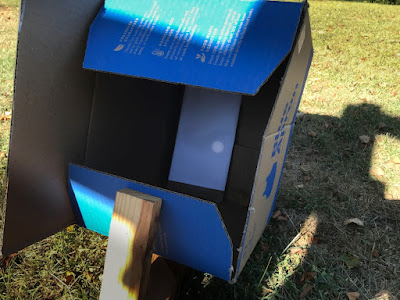Physics Photo of the Week - October 6, 2023
Long focus pinhole camera - safe solar viewer for partial solar eclipse on October 14, 2023
October 5, 2023
There will be a partial solar eclipse next Saturday - October 14, 2023. The eclipse begins about 11:23 am as the moon's disk begins to cover the Sun from the west side. Maximum coverage (about 45% for Western N. Carolina) occurs about 12:54 EDT. The Sun will be partially covered by the Moon until about 2:30 PM. All times are Eastern Daylight Time (EDT). This is only a partial solar eclipse. Maps of the eclipse are viewable at the website: https://science.nasa.gov/eclipses/future-eclipses/eclipse-2023/where-when .
Be very careful viewing the sun - even during eclipses! Never look directly at the Sun - permanent blindness may result!
Safe solar viewing goggles may be purchased from area science museums or on-line sites by searching for "solar viewing goggles".
Another device can be easily made at home for safe viewing: an "open-air" pinhole camera. A piece of cardboard - about 1ft x 1ft square - can be used for the pinhole. Use a nail, knitting needle, or small knife and punch a small hole in the center of the cardboard. The hole should be about 1/8 inch diameter. It does not have to be round. The hole can be a small square or triangle, but keep the size small. Take a sheet of white paper taped to another square of cardboard to use as a viewing screen. DO NOT TRY TO LOOK THROUGH THE PINHOLE AT THE SUN!! ONLY LOOK AT THE VIEWING SCREEN!
With your back to the Sun, hold the pinhole card with one hand and cast a shadow of the pinhole card on the ground or a wall. Use your other hand (or an assistant) to place the viewing screen in the shadow of the pinhole card. In the card's shadow you should see a clean round image of the Sun on the hand-held screen. This is an "open-air pinhole camera". You and friends can take pictures of the screen with the Sun's image with a handy smartphone camera, especially if you do this during the eclipse. Be sure to practice imaging the Sun before eclipse day.
The photo at the top (reproduced here) has a screen about 6 - 8 feet from the pinhole. The large distance enables a larger image to be viewed. (I had no assistant). The screen is in the bottom of a box to shield the screen from the bright blue sky. Daylight tends to "wash-out" the image by making the screen bright. (Projection screens work best in a darkened room.)
The photo (below) shows the pinhole card tacked to the lawn swing. It can also be hand-held. The box with screen is on the ground.
The photos (left) show the close ups of the pinhole. Notice that the pinhole is not round - it is roughly cut. NEVER LOOK DIRECTLY AT THE SUN THROUGH THE PINHOLE!
Why is the image of the Sun round and not square like the shape of the pinhole? A pinhole camera is extremely simple. The light from all parts of the scene is restricted to the light that is in line with the pinhole. A light ray from any single part of the the object scene can make its way through the pinhole and emerge from the other side of the pinhole and create a tiny spot on the screen. Myriads of rays from all parts of the scene all can pass through the pinhole an continue on straight paths to the screen. The simple geometry preserves the shape of the object, but the image is inverted from the scene. If the screen is placed close to the pinhole, we see the image of the pinhole's shape. A close image preserves the shadow cast by the edges of the hole. When the screen is sufficiently far from the pinhole, rays that form the image diverge enlarging the image, the shape of the pinhole disappears and the round shape of the Sun is seen. If the pinhole were made larger the image would be brighter, but the edges more blurred.
You can easily make a similar open-air camera if you can find a willing partner to hold the pinhole (rather than tacking to a post) at a proper place while you manipulate the screen in the box. A partner can be more willing if you let them trade places with you.
I will publish some pinhole images of the eclipse from alert readers. Please send them to me at the e-mail address below.
======================================================================
Physics Photo of the Week is published weekly during the academic year on Fridays by the Warren Wilson College Physics Department. These photos feature interesting phenomena in the world around us. Students, faculty, and others are invited to submit digital (or film) photographs for publication and explanation. Atmospheric phenomena are especially welcome. Please send any photos to dcollins@warren-wilson.edu.
All photos and discussions are copyright by Donald Collins or by the person credited for the photo and/or discussion. These photos and discussions may be used for private individual use or educational use. Any commercial use without written permission of the photoprovider is forbidden.








Comments
Post a Comment